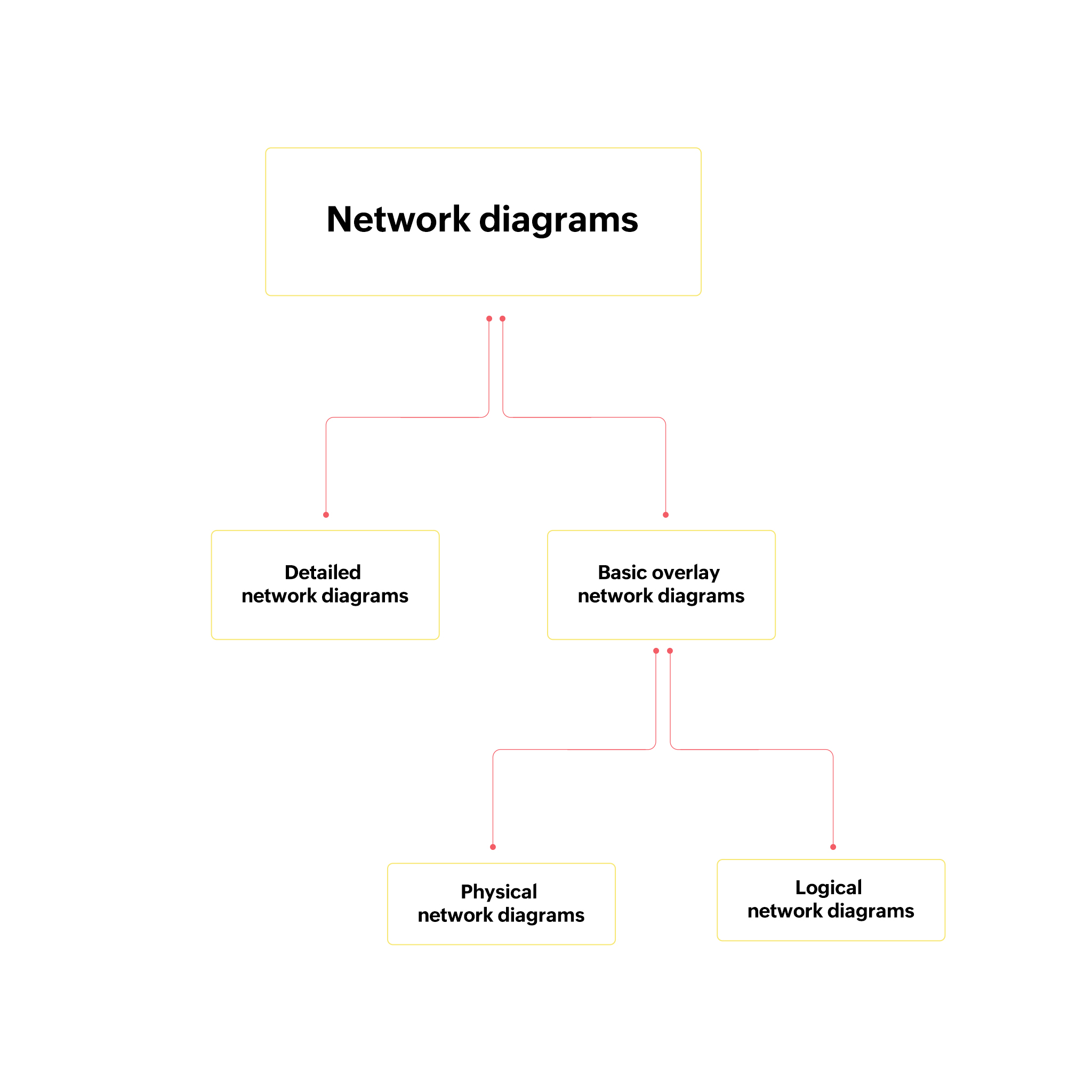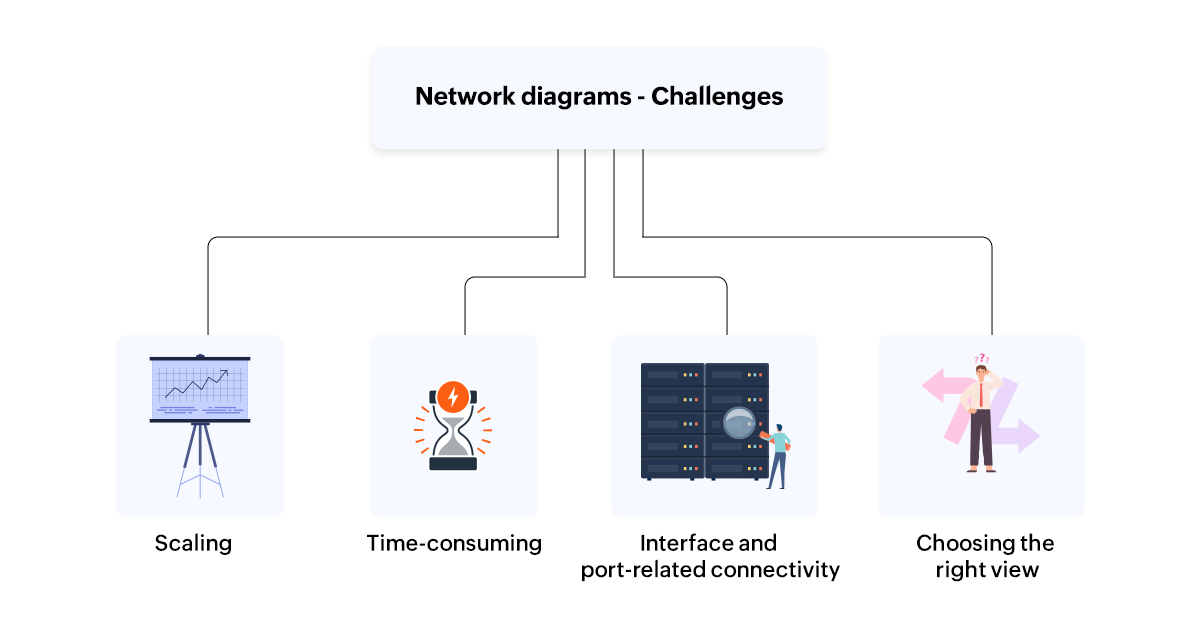What is a network diagram?
A network diagram is a pictorial representation of the network and the devices associated with it. It depicts the way the devices in a network are connected and also displays the flow of data within the network. Network visualization provides network admins with an overview of their network, and enables network admins to leverage this information to make well-informed decisions about their network.
Why is a network diagram important?
Network management is becoming more complex each day due to the increasing size of enterprise networks. The enormous size and dynamic nature make it difficult to scale the network to keep pace with its rising complexity. Without proper visualization, network admins might make uninformed decisions that could result in unexpected network outages. This could deliver a severe blow to businesses as it affects brand value and increases network operating costs. Hence, the need for comprehensive network visualization with the help of network diagrams becomes increasingly important. With network visualization, network admins can easily identify and resolve faults to prevent network downtime.
Types of network diagrams
Network diagrams can be broadly classified into two types:

Basic overlay network diagrams:
Basic overlay network diagrams give network admins an overview of their network without diving into the intricate details of the network. For example, a 3D floor view that portrays the connection between switches and servers represents a basic overlay network diagram. These low-level network diagrams might not display all the network details, but they provide network admins with an overview of their network. The basic overlay network diagrams are further divided into two: Physical network diagrams and logical network diagrams.
| S. No. |
Physical network diagrams |
Logical network diagrams |
| 1. |
Visualizes the networks from a materialistic point of view. |
Visualizes the network from a logical point of view. |
| 2. |
Represents the way devices are connected in a network. |
Represents the flow of data in a network. |
| 3. |
Operates out of the Open source Interaction (OSI) model layer - I. |
Operates out of the Open source Interaction model layer - III. |
Detailed network diagrams:
Detailed network diagrams give you in-depth information about and a comprehensive view of your network. For example, a LAN network diagram that depicts the connection between the devices, routers, switches and nodes represents a detailed network diagram. These high-level network diagrams help gather critical insights about your network that might come in handy while making decisions regarding your network.
Network diagram examples
Challenges faced while drawing a network diagram
Following are some of the network diagram challenges

- Scaling: Enterprise networks are becoming increasingly dynamic, and the layout of the network changes constantly due to their varied load. Scaling must be taken into account before drawing up a network diagram, often a complex process. When an organization ventures into a new market, or runs into a situation where it needs to expand its network, the proper visualization of the existing network is essential. By gathering insights about the network's topology and hierarchy from the network diagrams, scaling can be accomplished more easily.
- Time-consuming: An enterprise network will be associated with a lot of devices, routers, switches, interfaces, etc. Getting these details correct takes a great deal of time and manual effort that could otherwise be focused on other critical aspects of a network.
- Interface and port-related connectivity: A comprehensive network diagram must include intricate details, such as interface and port-related connectivity. But getting oneself acquainted with this information for an enterprise network is a strenuous task.
- Choosing the right view: Certain cross-functional areas might require overlapping views. Network admins need to be cautious when deciding the type of view they will utilize since going with the wrong type might lead to network downtime.
What are the must-haves of a network diagram?
A network diagram is used to visualize a network. Here are some of the key features that a network diagram must convey:
- Issue isolation: A network diagram must be legible and easily interpretable so that, in the event of an issue or malfunction, it can be used to identify the problem and isolate the impacted devices to prevent network outages.
- Onboarding devices: Enterprise networks can be colossal in size and might consist of many devices. This herculean size might impede your visualization efforts, especially when you need to introduce new devices into your network. Network diagrams must be legible and have clear entry and exit points so that it is easier to identify the point of deployment of these devices into the environment.
- Technical evaluation: It is important to ensure that the devices in a network are operating at their optimum capacity. Network diagrams must be instantaneous and display the real-time status of the devices. This helps network admins evaluate the device's performance and prevent possible outages.
- Root cause analysis: An enterprise network with a lot of devices associated with it might be prone to outages due to the complexity of network management. A network diagram must be in an easily interpretable format that allows you to identify the root cause of the outage.
Network diagramming tips

- Know your audience well and create network diagrams that serve their purpose.
- Use proper icons that help your audience better understand the network devices.
- Clearly define the entry and exit points of your network infrastructure.
- Use legible connection lines and arrowheads to represent connections between network devices.
- Mark legends clearly to indicate the status of network devices.
- Pick the appropriate view that you want to visualize your network with.
Best practices to follow while drawing a network diagram
- Unique diagrams: A network diagram of an enterprise network might be massive considering the sheer number of devices associated with it. While the diagrams need to be comprehensive, it is also important to not overlap two or more views since it might be hard to interpret.
- Agile diagrams: Networks today are becoming more dynamic. Since the layout of the network changes constantly, visualization might be difficult. To compensate, network diagrams must be agile so that any changes to the network are carried over to the corresponding network diagram without difficulties.
- Picking an automated and dynamic tool: Due to the dynamic nature of enterprise networks, it is important to choose a tool that automatically carries over the changes implemented in the network to its respective network diagram.
Uses of network diagrams
- Developing contingencies: In an enterprise network, even the malfunctioning of a single device might lead to disastrous outcomes, such as network outages. Network admins should have a contingency in place in case a device malfunctions. With a proper visualization format, such as network diagrams, network admins can develop a contingency plan to minimize the impact.
- Network planning and expansion: Due to the dynamic nature of today's enterprise network, the network layout changes often. Networks keep expanding to meet an increasing demand. To carry out network expansion, it is important to plan for it utilizing an overview of the network. Network diagrams help paint a picture of the entire network and aid network admins in planning for network.
- Keeping track of the changes in the network environment: Devising a network diagram and documenting the layouts helps network admins since the network diagrams can serve as future references for network planning and construction.
- PCI DSS compliance: The payment card industry data security standards (PCI DSS) is a set of industry level security standards that must be complied with if a business stores, processes, or transmits credit card data. According to requirements 1.1.2 and 1.1.3 of the PCI DSS, it is mandatory for organizations to have a detailed network diagram that identifies the connections between the cardholder's data environment and other networks. To ensure that PCI DSS is strictly complied with, organizations must have a comprehensive network diagram that depicts the entire flow of credit card data across their network.
- Remote rectification: In the event of network outages, finding the root cause might be difficult due to the size of the network. Network diagrams help you isolate the issue and remotely resolve the same.
- Topological view: Network diagrams help you understand the topology of your network since the devices are portrayed legibly in a hierarchical format that can easily be interpreted.
- Virtual machine topology: Visualizing virtual machines proves to be crucial for a network. These non-tangible devices can be visualized in the form of a network diagram that can be easily interpreted to make well-informed decisions.
OpManager: The ideal network diagram software
ManageEngine OpManager, holistic network monitoring software includes a powerful network diagram toolkit. It enables you to visualize your network in the form of reports, dashboards, Layer2 Maps, Business Views, NOC views, 3D Rack Views, and 3D Floor views. With automated network diagrams and a wide range of network diagram formats, OpManager helps you accomplish network diagramming easily and efficiently.
Download OpManager, network diagram software to know more about its capabilities. Learn more about Network diagrams in OpManager.


